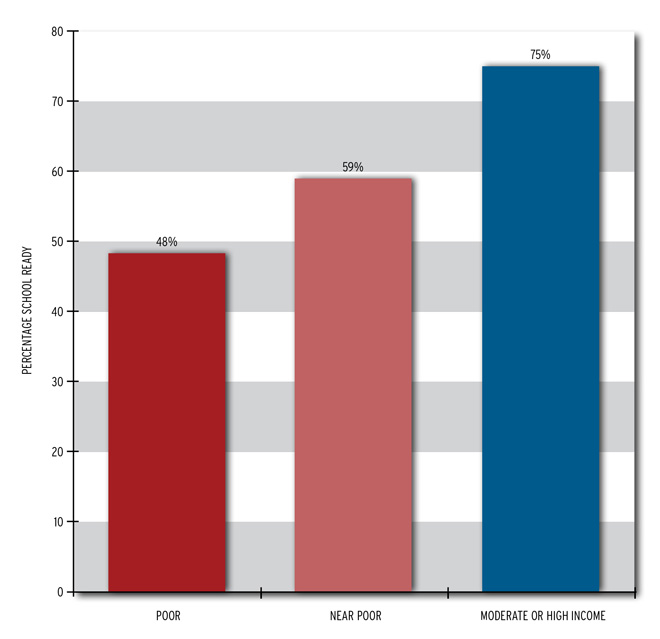Back-to-school time is around the corner, and children and parents around the country are getting ready. The start of school is particularly exciting for five-year-olds entering school for the first time.
Unfortunately, only about half (48 percent) of poor five-year-olds who enter kindergarten this fall will be “school-ready” in terms of having early math and reading skills, good physical health, and age-appropriate behaviors (some ability to pay attention and work on task, not too many temper tantrums or other problem behaviors). By comparison, 75 percent of children from families with moderate and high incomes will enter school ready to learn (see figure below). Whether this disparity is because of poor families’ inability to secure the resources needed for healthy development (such as nutritious meals, high-quality child care settings, and neighborhoods free of crime and pollution) or because of the negative effects of poverty on parental stress and family dynamics, large numbers of poor children lag behind their peers and start school at a disadvantage from day one.
Figure 1: Likelihood of Being Ready for School at Age Five, by Poverty Status at Birth

Many poor children face a combination of risk factors that threaten their development during early childhood, as detailed in a paper I wrote on the school readiness of poor children. For example, mothers of poor children are more likely to be depressed than other mothers and less likely to exhibit warmth and sensitivity (during videotaped observations of parent-child interactions) or to read books or sing songs to their children. Many poor mothers also lack a high school diploma, another factor contributing to their children’s lower levels of early academic skills.
What can be done to improve the school readiness of poor children? Policies to increase family income, through earned income tax credits or other wage supplements, have been shown to have a positive impact on children’s academic skills during early and middle childhood. Money really does matter, as Greg Duncan and his colleagues conclude from a rigorous analysis of findings from experimental welfare-to-work programs. Children also can benefit from services that address specific parental characteristics, such as maternal depression (see my colleagues’ project on “Linking Depressed Mothers to Effective Services”). And they can benefit from parenting programs such as the nurse home visiting program, which coaches first-time, low-income mothers on a range of parenting issues.
In my paper, I simulated the possible effects of three interventions to improve school readiness—expanding preschool programs to all poor four-year-olds, providing smoking cessation programs to poor pregnant mothers who smoke, and offering nurse home visiting programs to all poor mothers. Of the three, I found that preschool programs for four-year olds has the most promise for improving school readiness at age five.
Let’s build a future where everyone, everywhere has the opportunity and power to thrive
Urban is more determined than ever to partner with changemakers to unlock opportunities that give people across the country a fair shot at reaching their fullest potential. Invest in Urban to power this type of work.